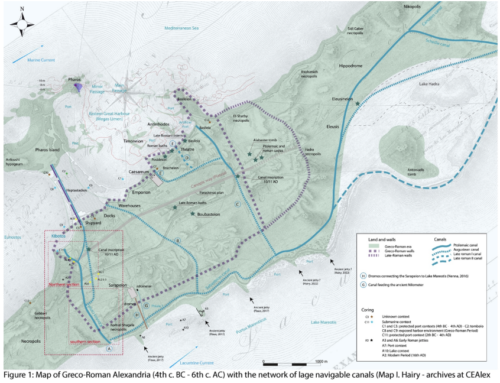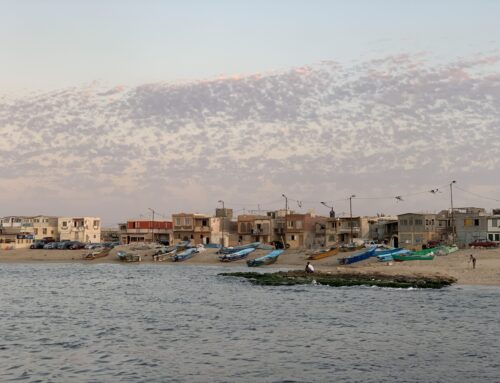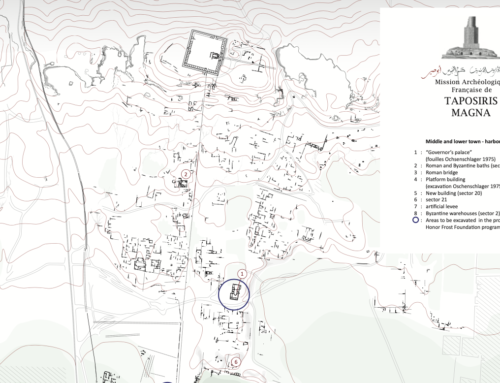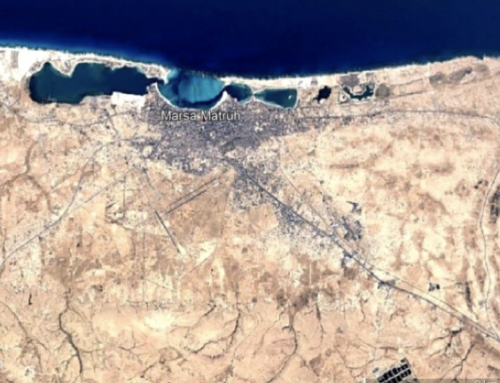Ayn Sukhna Archaeological Mission – ongoing
Dr Claire Somaglino
Summary

View of one of the 2019 excavation area, where Middle Kingdom and Old Kingdom layers were excavated. Most of the buildings are leaned against the cliff.
Since its identification in 1999, and the beginning of the excavation in 2001, the site of Ayn Soukhna (northern Gulf of Suez), has proven to be a Pharaonic harbour and logistic platform for the Egyptian expeditions to South Sinai mining area (copper and turquoise) and Punt (southern Red Sea). It was a key feature of the Egyptian network in the Red Sea during Pharaonic times. The site was sporadically but regularly occupied throughout a very long period, from the reign of Khafre during the 4th dynasty (ca. 2470 BC) to the reign of Amenhotep III at the end of the 18th dynasty (1353 BC), the two main peaks of its occupation being the Old Kingdom (ca. 2370-2153 BC) and the early Middle Kingdom (ca. 1950-1910 BC). It displays the now well-known features of Pharaonic Red Sea intermittent harbours: a series of 10 galleries excavated in the mountain to store equipment between two expeditions, as well as a living and operation area, between the galleries and the sea.
The site had a lot of assets, which explains its prolonged use: it is close to Memphis capital city (120 km as the crows fly), established on a site with a spring and a small oasis, in a bay that proved to be a somewhat sheltered anchorage, dominated by mountains that constitute a landmark for the sailors. The foothills of the mountains, where the galleries are dug, are conveniently close to the seashore (about 400m). The discovery of two dismantled charred boats from the early Middle Kingdom in two of the galleries has been, besides all the features mentioned above, one of the significant discoveries on the site. They are amongst the oldest seagoing vessels found in the world.
The excavation is now focused on the settlement in order to gain a better understanding of the logistics of the expeditions, as well as their day-to-day life. Between the foothills of the North-Galala mountains and the Red Sea seashore, it encompasses workshops, dwellings and storehouses, cooking areas and baking facilities, but also the harbour itself (on approximately 300 m E-W for 100 m north-south). The building of a hotel and a road along the coast before the excavation has deprived us of the connection between the site and the sea. Nevertheless, we discovered structures linked to the harbour activities, the most striking being a 17,5m long pit dug in the bedrock, which has the exact shape of the “boat pits” observed near the pyramids in the Memphite region. This is the first time that such a structure has been found in its original setting. Another feature, also of the Old Kingdom, has been excavated more recently (2014-2017) and may be related to harbour activities: two smaller pits, also dug into the bedrock, paralleled by a kind of water pipe (used to reshape the wooden planks before reassembling the boats?). In 2019, we also found an Old Kingdom stele with an expedition account that confirms the key-role played by boats in supplying commodities to the mining teams in South-Sinai during the expedition.
See below for updates from each fieldwork season.
You can also watch a webinar by Dr Somaglino as part of the NAS Under The Water Webinar Series here, or find out more on the project website here.
Methodology
The excavation work in Ayn Sukhna since 2012 entirely focused on the lower part of the site, where commodities for dwelling, storage, preparation of food, as well as artisanal activities are found. All the remains are dated to the Old Kingdom and the beginning of the Middle Kingdom. A few features there are also linked to the harbour activities, even if the connection between the site and the seashore, some 200m away, is lost because of the building of a road and a hotel. For instance, there is a 17,5m long pit dug in the bedrock, and whose shape is the same as the “boat pits” observed near the pyramids in the Memphite region. Another Old Kingdom feature has been excavated more recently, and may be related to harbour activities: two smaller pits, also dug into the bedrock, paralleled by a kind of water pipe.
In 2019 we continued the excavation of parts of the lower area. Our goal is to enhance the understanding of the logistics of Egyptian expeditions to South-Sinai and Punt, and of their day-to-day life.We resumed our work in area S6-South and K14-W and were able to find new Old Kingdom layers, mainly artisanal area (an area for food production, especially bread, another for the sealing of jars with clay jar stoppers).
We also made there two very important finds. First a few shards of an imported pottery, particularly a fragment of the rim. They belong to the same pot as the imported shards we found two years ago about 15m away, and may well be from the Southern Red Sea, whose cultures during this period are very poorly known. We also found, reemployed in Middle Kingdom building, an Old Kingdom stele. It is the first document of this type found in the lower part of the site (inscriptions were all found around or in the storage galleries in the upper part). This stele, made in local sandstone, belongs to the scribe Senenidu, who is known otherwise by other rock inscriptions from South-Sinai, and maybe by another fragmentary document in Ayn Sukhna. He was engaged in an expedition during the reign of king Djedkara-Isesi, at the end of the 5th dynasty. As in wadi Maghara, Senenidu is featured here with his wife – whose title and name are given – and his son. On the left part, an expedition account is painted in red. The text confirms the key-role played by boats in supplying commodities to the mining teams in South-Sinai.
We also managed to remove the huge heaps of debris located on the north of Kom 14, near the Old Kingdom « boat pit ». A first test pit was made in this new area that showed the presence of both Old and Middle Kingdom layers. We hope to begin an extensive excavation there during the next season.
At last, we continued the excavation of layers from the beginning of the Middle Kingdom, in particular, some copper workshop. This allows us to refine our understanding of the copper « chaîne opératoire ». Ayn Sukhna is also a unique site on this point of view for the Middle Kingdom.
Results
The 2019 expedition allowed us to enhance our knowledge of the older phase of occupation in Ayn Sukhna, as we continued the excavation of several Old Kingdom layers in the lower zone of the site. We discovered more artisanal areas, dedicated chiefly to food production, as well as important artefacts from this period. Notably, a few shards of a ceramic that, we suggest, was imported from the Southern Red Sea, as well as a 5th dynasty stele. This monument belonged to the member of an expedition under the reign of king Djedkara-Isesi. It bears, in fainted hieratic, a rare account of an expedition, which confirms the boat rotation system set to supply the Egyptian miners in South-Sinai.
We also carried on the excavation of Middle Kingdom layers, with the discovery of a new copper workshop and its surroundings. Its analysis allowed our archeometallurgists team to find new details about the chaîne opératoire, in particular, about the exact processing of the product from the redox furnaces. In the same area, we cleaned a rare mud-brick structure (the vast majority of the buildings are made in dry stone). We hope to excavate it next year to discover its function.
At last, a new zone was cleared of debris to launch the next phase of the excavation. The first test pit we made there showed the potential of this area, with layers from both the Old Kingdom and the beginning of the Middle Kingdom. We very much hope to find there new structures linked with the harbour facilities.
The ongoing excavation of the harbour of Ayn Sukhna contribute to the enhancement of our understanding of the logistics of the Egyptian expeditions to South-Sinai mining area mainly, but also to Punt, during the Old and Middle Kingdoms. We discover every year more indications about the organisation of the supply system, the way the food was cooked on-site, the copper metallurgy at the beginning of the Middle Kingdom, etc. Moreover, the newly discovered imported pottery gives precious indications to ascertain the links between Ayn Sukhna and the Southern Red Sea during the Old Kingdom. The stele of Senenidu is another exceptional discovery to understand the involvement of the Egyptian missions in the Red Sea during the 5th dynasty and the prestigious reign of Djedkara-Isesi.
Future Plans
We plan to continue the excavation of the lower part of the site, in particular, the areas where we identified both Old and Middle Kingdoms remains, as they enlighten the beginning of the Egyptian settlement in Ayn Sukhna.
We also plan to excavate the vast area cleared of debris in 2019, and which is located to the north of the Old Kingdom “boat pit”. This new phase of the excavation will provide a better understanding of that unique feature, and maybe allows us to find other features linked to the harbour activity.

Methodology
During the 2020 expedition, we retrieved more information about the Old Kingdom layers in Ayn Soukhna. We finished the excavation of K14-West area and continued to work in S6-North. In the two contiguous areas, we were able to gain a better understanding of the artisanal activities that took place there: an area dedicated to the production of jar stoppers from local clay, with small clay pits (5th dynasty); more hearths, in particular, to bake bread (most of them from the 4th dynasty). Around the jar stopper workshop, we found a small limestone amulet, which takes the form of a miniature anchor, and reminds the boat activity on site.
In the new area excavated, Kom 14-North, the Old Kingdom remains were, in the end, scarce. The thick layer we identified last year in the test pit was a reject layer resulting from the installation in Kom 14 area, but no more structures were identified to the north of the test trench.
We had, though, the surprise to find a new Old Kingdom area to the west of the site, where no Old Kingdom remains had been identified before. The enlargement of the S39 area disclosed Old Kingdom layers directly on the bedrock: fireplaces dug in the sandstone, as well as a pit leaned with shards and covered with clay, very similar to the artisanal structures found last year in Kom 14-West area.
Our knowledge of the Early Middle Kingdom occupation of the site was also enhanced by the excavation of the small built part of area Kom 14-North and the discovery of a storage pit (cache) in area S6-North. This last feature contained an ensemble of five storage jars, one small jar, two bowls, one small fragmentary painted jug, a fragmentary beer vase and fourteen stone tools (grinders). Most of them presented the same post-firing mark on the shoulder, which is a welcome confirmation of our hypotheses about the organisation of the crews on site. We suppose that one mark corresponds to one part of the crew, which was given its supply by the administration and had to transform it. These jars and tools were stored in order to be retrieved during another expedition by the same crew.
The excavation in area S39, opened two years ago, was resumed and enlarged this year. It permits us to understand better the chronology of the occupation and the succession of buildings. Of particular interest here is the study of the management of the copper workshop, and its waste. We excavated a thick layer of rejects on the south of the workshop, along the slope of the sandstone promontory. It was full of ceramic shards, stone tools, and copper waste. Their study is important to reconstruct the running of the workshop as well as the different phases of use of the furnaces. In the wall of one of the stone buildings, we found a miniature stela (?) made in limestone, with incised drawings figuring a monkey with geometric and floral patterns. It is the first object of this type found on the site.
Summary of Results
The excavation work in Ayn Soukhna since 2012 entirely focused on the lower part of the site, where commodities for dwelling, storage, preparation of food, as well as artisanal activities are found. All the remains are dated to the Old Kingdom and the early Middle Kingdom. A few features there are also linked to the harbour activities: a 17,5m long pit dug in the bedrock, and a structure comprising two pits, also dug into the bedrock, paralleled by a kind of water pipe (all from the end of the 4th dynasty).
We focussed the excavation on the lower area of the site to enhance our understanding of the logistics of Egyptian expeditions to South-Sinai and Punt, and their day-to-day life. To that end, we need an extensive excavation to understand the organisation of space and the living conditions, as well as a rigorous and precise excavation of the structures, in particular the artisanal areas (copper workshops in particular). The 2020 expedition permitted us, amongst other things, to have a better view of the overall organisation of the site, in particular the alternation of built and open spaces. For instance, the presence of a building-free space to the north of the Old Kingdom pit (area Kom 14) gives us another clue about the function of this feature: maybe the boats rebuilt or repaired there were heaved on the sand between the pit and the sea.
2021 – 2024 Plans
The team have now been awarded a large grant award by the Foundation. This will contribute to fieldwork at the site from 2021 to 2024. The objectives of the next phase of the project are outlined below.
Ayn Soukhna is one of those rare settlements in Egypt where an extensive excavation is being carried out. The main functions and chronology of the site are now fully understood, namely a harbour and logistic platform for the expeditions from the Nile valley, going to the South Sinai mining area to retrieve turquoise and copper ore, or travelling to the southern end of the Red Sea towards the land of Punt. The site is organised in two main parts: the upper part with a storage system of 10 galleries dug in the mountainside during the Old Kingdom – and reused during the Middle Kingdom – for the storage of boats and equipment between expeditions; the lower part with commodities for dwelling, storage, preparation of food, as well as artisanal activities. Boats were reassembled there, and copper was smelt in numerous workshops, of a type, to date, unique in Egyptian archaeology.
We then decided to launch a careful spatial analysis and put the focus on new issues, to further our knowledge of the logistics of these expeditions, of the day-to-day life in Ayn Soukhna, and to gain a better understanding of the Egyptian network in the Red Sea during Pharaonic times. We concentrated, for instance, on the way groups of Egyptians from the Nile Valley reacted and acted outside of their usual environment: how did they adapt to the living conditions in a coastal and marginal area? Even if the Egyptians knew very well the resources of the deserts surrounding the Valley and were used to exploit these resources, this almost desertic seashore was not their usual habitat. We also try to understand the way central institutions supplied them and how these supplies were apportioned among different parts of the crew and transformed. Recent discoveries (2017 and 2019) of foreign potteries gave us new material to have an insight into the contacts between the Egyptians and the Land of Punt during the Old Kingdom, as well as the regular discovery of small pieces of obsidian (ongoing analysis). We are thus able to deepen our knowledge of these very debated relations.
Lastly, we focus on technical issues:
– Boats when possible: apart from the exceptional charred remains of two boats of the early Middle Kingdom found in two galleries, a few structures dug in the bedrock in the lower part of the site may be linked to the reassembling and maintenance of seagoing boats during the Old Kingdom.
– The “chaîne opératoire” of the copper: Ayn Soukhna is a unique site for the study of copper metallurgy in the Middle Kingdom. The 80 or so redox furnaces were there to transform the copper ore before its transportation to the Nile valley. A few smelting furnaces were there to manufacture and repair the tools needed on-site, including some pieces for the boats (copper strips for instance). The workshops were mainly located in the lower part of the site and give great insight into the process and the work conditions.
– The “chaîne opératoire” of the bread baked on-site.
2021 Archaeological Mission
The excavations took place from 19/05/2021 to 18/06/2021 and were concentrated in the settlement (lower site area). The excavations were pursued in area S6-North, where we excavated the first layers of occupation of the site. They date mainly from the end of the 4th dynasty and the 5th dynasty. We found a concentration of seal impressions along the stone cliff, which helped immensely to date these layers more precisely. First, we retrieved a well-preserved seal impression giving the birth name and Horus name of Sahura, the second king of the 5th dynasty. Second, we found dozens of small fragments of the mud used to seal jars and bags in the layers underneath. Some of them were inscribed, and many show parts of the Horus name of king Userkaf, the first king of the 5th dynasty. These seal impressions provide new and important information, as, to date, we did not know of any expedition sent by this king to the South-Sinai mining area.
Underneath these layers, one or two layers showing essentially fireplaces located in an open space were excavated. We retrieved lots of bread molds there, showing an intense activity of baking bread. We also resumed our work in the adjacent area S41, where a well-preserved seal impression from the reign of Djedkara-Isesi (end of the 5th dynasty) was found. It mentions a controller of scribes.
On the western side of the settlement, in area S39, we decided to enlarge the excavated area. Last year, we finished excavating there a copper workshop from the early Middle Kingdom, and at the end of the excavation, new layers of the Old Kingdom began to appear. This year, we continued to explore these layers, constituted mainly of fireplaces and pits dug in the slope of the bedrock.
We also opened two other trenches to the west of S39 to evaluate the density of the archaeological layers there. The first one is located along the low cliff framing the settlement in the lower area. Usually, the remains are more numerous there since the ancient teams used this cliff to dig some storage devices or as a support to lean some of the buildings. As a result, three different phases of Early Middle Kingdom buildings or layers began to appear that we will excavate next year. In the other trench pit, on the north of S39, we also found layers of the Early Middle Kingdom: fireplaces, waste, two anchors, but also part of a building. We will enlarge this trench next year to make an extensive and complete excavation of this new building.
The results obtained during the 2021 mission have made it possible, by following the issues that have guided the excavation for several years, to deepen our knowledge of the logistical organisation of Egyptian expeditions to the mining area of South Sinai. They also allow us to obtain a more precise vision of the daily life of the expeditionary troops on this intermittent harbour. Finally, we continue to gain a precise knowledge of the copper “chaîne opértoire” during the early Middle Kingdom, which each new furnace and workshop excavated allows us to do.
The 2021 excavation also clarified the chronology of the Old Kingdom expeditions, thanks to the discovery of seal impressions bearing royal names.

The 2023 campaign focused on two main areas: the western fringe of the expeditionary camp in the lower part of the site (S39-B) and wadi 3, to the west of the upper part of the site, where we located since 2022 new Early Middle Kingdom copper metallurgy workshops.
Area S39-B had been extended to complete the excavation of a large Early Middle Kingdom building. To the west, we found the western and southern walls of room E9. The room is built on the gebel and presents some light amenities in its southern part. To the west of E9, rooms E11 and E12 are built on the slope of the gebel. A jar stand with the base of a jar still in place can be seen in the southeast corner of E12. Further north, we cleared the western part of room E8 and found a deep pit containing eight carefully stored complete jars.
A new group of rooms has also been identified in the northern extension of the zone: E15, E14, E16. The main entrance to the building appears to be to the north (to the coast), with an actual entrance room. Two other pits containing a total of eight complete potteries the ancient Egyptian teams stored at the end of an expedition were also found in these spaces.
Finally, to the south of S39-B, at the junction with S39-A, we identified a new copper metallurgy workshop (F107 to F111).
We also continued excavating Wadi 3 in the upper part of the site. The western part of Wadi 3 where we had carried out three test pits in 2022, was explored more extensively this year. It revealed a series of Early Middle Kingdom copper metallurgy workshops and a much denser occupation than the eastern part of the wadi. To the south of the area, the first workshop, of modest size, was built by digging into the bedrock on the western flank of the wadi. It contains a battery of three reduction furnaces (F96-98), almost reduced to ground level. Immediately to the north, another much larger workshop is leant against the gebel to the west and contains, exceptionally, a battery of six reduction furnaces (F99-F104) preserved at different heights. Not all the furnaces were in use simultaneously: the doors of two furnaces were completely blocked by waste from sorting the reduction process, while the other four furnaces were still working. A low wall binds the workshop area, and the floor is made of muna. A room adjoins the workshop to the north, where we identified two fireplaces. At last, another workshop is built on the north of this room. It encompasses two redox furnaces (F112-F113), not very well preserved.
On the eastern flank of the wadi, from south to north, we excavated a room adjoining the gebel and another metal workshop, including two reduction furnaces (F105-F106). The floor of the workshop, built of muna, still features a sorting stone surrounded by a clay coil. In this space, the contents of the furnaces were sorted as they came out to extract as many copper prills as possible.
At the end of the 2023 mission, we almost finished excavating the large dry-stone building in sector S39-B (20 m x 17 m). It has enabled us to identify several phases of occupation of the building, quite close together in time during the Early Middle Kingdom, and provides more data for assessing the organisation of the space and understanding the functionality of the rooms. Between the two missions, 2022 and 2023, we found six storage pits for ceramics in the building. It is the largest concentration of pottery storage pits in the entire camp and constitutes a valuable addition to our knowledge of how the Pharaonic teams tidied up the site at the end of their missions. Some of the most precious heavy equipment was stored in the galleries in the upper part of the site, while other items (storage jars, mainly a few stone tools) were stored in pits or the corners of certain rooms in the camp in the lower part. The men aimed to find them on the next mission and reuse them. Excavation of this building also provided numerous clues as to the recycling of objects, particularly ceramic vessels, with an area dedicated to transforming storage jars into open vessels (cut jars).
Finally, the excavation of Wadi 3 has enabled us to better appreciate the density of occupation of the site during its most intense phase of activity, at the beginning of the Middle Kingdom. The increase in the number of copper metallurgy workshops excavated provides an exceptional opportunity to study the copper production chain with cutting-edge techniques, and thanks to this extensive excavation, Ayn Sukhna has become one of the main sites for the study of Pharaonic metallurgy.










